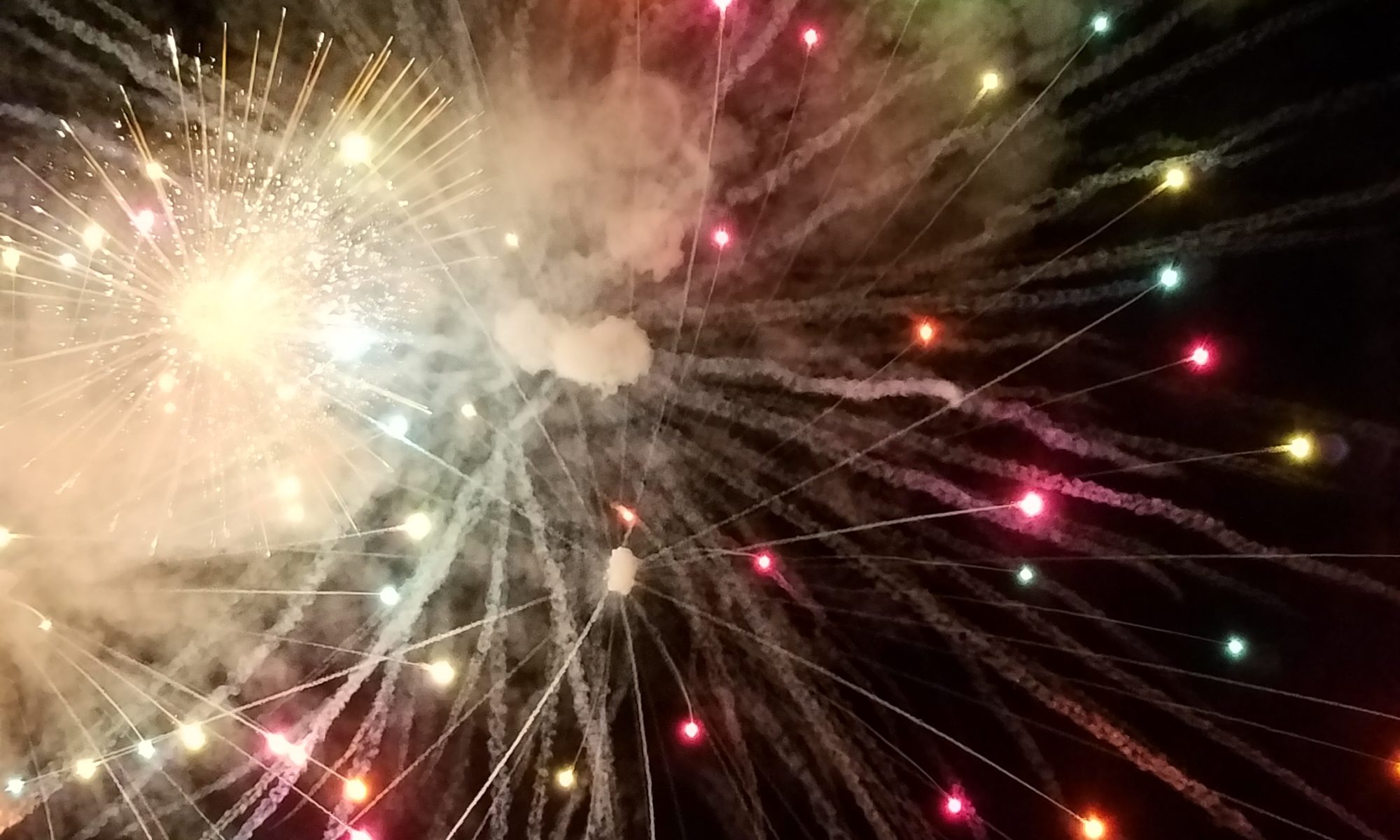Just a few days ago I dressed up like a peacock, complete with mask and a tutu-like bustle for the Masquerade Ball. It was a fun night of music and dancing and bright colors and sparkles, and laughter. Fireworks were going off in the near distance when we got home. Then last night the major fireworks display launched right over our heads. One could say the whole city undergoes a change at this time each year, for Carnaval. But, the costumes, the sparkles and confetti don’t last. The Monigotes will come down, the stages and the bathrooms will be packed away and the noise and commotion will subside. And life will go on without the spectacular.
Every year, we mark the movement from the season of Epiphany into Lent on this Transfiguration Sunday. Firey chariots, dazzling clothes, holy mantles of power, blinding clouds. Elijah ascending in a whirlwind, Jesus climbing a mountain with Peter, James and John. Like Carnaval, there is nothing subtle about these stories.
Dazzling stories like these are sprinkles throughout the Scriptures, and in the testimonies of believers of all ages and times. For those who are granted such numinous experiences words are profoundly limited to express the ineffability, transiency and vivid sense of knowing that the earth is full of the glory of God. I’ve had a few moments in my life that I would call mystical experiences. I’ve often included references to those times in my sermons for Transfiguration Sunday.
But what caught my attention this year were these things: that only 3 of the 12 disciples got to see the Transfiguration. Like those other nine, I suppose the majority of Christians don’t ever have a mystical experience. Jesus shushed those who did see. And neither the story of the firey chariot, nor the story of Jesus bright as the sun on the mountaintop are happy stories. Both of our readings today include not just the luminous, dazzling light of God’s glory but also traces of sorrow, loss, and confusion. Both are about change, transformation, and movement ahead into the unknown.
In Mark’s gospel the transfiguration lies right in the center of the gospel’s structure, form that point onward the path of Christ is toward the cross and Jerusalem. While Peter wants to stay on the mountain top and bask in the glorious light, Jesus leads on, back down the mountain into what lies ahead. Each of these stories represent a threshold of sorts and the challenge of stepping forward over a kind of boundary line. Maybe it’s human nature and our survival instinct that make us hesitate to cross over out of our comfort zones without hesitation. Nostalgia, ambivalence, security all probably play a part. But there’s a tug in these stories, to teach us that crossing over into what lies ahead keeps our faith dynamic. Without growth, change, movement we die.
Let’s look in to the backstories of these texts. In 2nd Kings, we learn that Elijah had called Elisha as his heir and follower when Elisha was still a young man, working at home in his father’s fields. Elijah walks out into the muddy fields, wraps his cloak around Elisha’s shoulders, and calls him away to a new path. Seven or eight good years go by, during which Elisha becomes Elijah’s shadow. He follows with love and devotion, and eagerness to learn.
The story of Elisha following Elijah around even though Elijah keeps trying to send him off on his own is one of those scriptures that always make me chuckle. In my imagination, I can see it so clearly. Elijah is old and tired and probably just wants some peace and quiet for a change.
My sister Betsy is 2 ½ years older than I am. I trailed along after her like a shadow when we were little. She paved the way for me, talked to the adults we encountered for us, took my hand and led me. I remember her complaining, sometimes, to my mom that I wouldn’t leave her alone. I’m pretty talkative; I always have been. Betsy is quieter and needs her space. I can just imagine how exhausting it must have been to be my big sister at times. Maybe it was something like Betsy felt with her little jabberbox of a sister tagging along.
In the scripture, Elijah tells his disciple three different times the he needs to take the next part of his journey alone and that Elisha should to stay behind. A few other prophets even try to help Elisha let go. One by one they pull Elisha aside to say, “Hey, are you sure you want to be with this guy. He’s not long for this world.” And, Elisha would say, “Yes, I know what I’m doing, now be quiet.”
It’s understandable. We hesitate too—when we are standing at a turning point, a threshold of vocation, or retirement, of identity and relationship. Everything Elisha has known is about to change and he’s feeling pain and loss and bewilderment. Will he be able to fill his calling without his mentor? Can he decipher God’s word on his own, without help? Can he step forward and be a leader instead of a follower?
I suppose we all understand those questions. We get used to a certain way of being in the world, of relating to our families. We spend a great deal of time practicing our vocations, identifying ourselves by what we do, where we belong, where we’re from, how we “do church.” Then it changes. By the time this whirlwind event occurred in the lesson today, Elisha had become accustomed to finding his God and his purpose through his mentor. He doesn’t want that safety net pulled away.
But in this story, as in our lives, there’s no way to avoid the thresholds before us. The chariots come, the whirlwind descends and Elijah leaves. Centuries separate us from this fiery display of God’s power. We wonder what did all that drama accomplish? The fire, the wind, the horses? Were the fireworks for Elijah, headed beyond this life? Or was Elisha the one who needed to understand, right from the beginning of his career, that God’s glorious unveilings may be spectacular but that epiphanies aren’t the be-alls and the cure-alls for life? Elisha saw glory, that’s for sure. But he also saw a point of no return, and his response was neither certitude nor joy. He tore his clothes and grieved.
I know few scenes in the Bible more poignant than the one that ends this story. As quickly as the vision comes, it departs again. There is no afterglow, no surge of prophetic authority or knowledge as Elisha lies grieving in the dust. Only silence. Only loss. Only questions.
Why? Because it’s not the vision that saves Elisha. The vision is glorious, of course, but divine wonders alone don’t save anyone. Elisha’s salvation comes in the long silence after the glory. It comes when he still has no idea whether Elijah’s “double portion” will rest on him, or not. It comes when he chooses to stand up, shoulder his grief, take up his teacher’s mantle, and cross the threshold into a new and unfamiliar life.
It’s clear from the details in the story that this choice is neither easy nor inevitable. But the decision Elisha makes bears witness to the faith epiphanies can forge in us when we make the hard choice to cross over. A battered faith, a trembling faith, a scorched faith. The faith that yields abundant life.
The second dramatic story in this week’s readings — that of Jesus’s Transfiguration — is recorded in all three Synoptic Gospels. Over the centuries, it has steadily accumulated meanings — most of them thickly theological. Growing up, I was taught that the Transfiguration is important because it reveals Christ’s divine nature, foreshadows his death, secures his place in the stream of Israel’s salvific history, and prefigures his Resurrection.
All of this is true and no doubt important. But for me, the story pivots around Peter, James, and John, the three terrified disciples who witness Jesus’s transfiguration and just about lose their minds.
Like Elisha, these friends of Jesus have spent years following him around, listening to his teachings, and witnessing his miracles. By the time Jesus invites them to the mountaintop, they have perfectly good reason to believe they know their Master. They know him as a teacher, a storyteller, a healer, and a traveling companion. His face, his manners, his mission — all are familiar to them. Familiar, endearing, and safe.
But then, on the mountain, the unimaginable happens. Before their very eyes, Jesus changes, becoming at once both fully himself and fully unrecognizable. And suddenly, just like Elisha, Jesus’s stunned disciples find themselves standing upon a threshold. The man they thought they knew is suddenly more, suddenly Other. And the path he’s walking — towards Jerusalem and death — is suddenly far more grim than they could ever have imagined.
In other words, one phase of their life with Jesus is ending. What will it look like to begin another? They have journeyed with Jesus the minister, the rabbi, the healer. Will they now journey with him towards the cross? Or will they insist — as Peter briefly does in his fear and confusion — on remaining exactly where they are, sedentary and safe?
On Transfiguration Sunday, we come to the end of another liturgical season. Having seen the light of Epiphany, we prepare now for the long shadows of Lent. I don’t know what thresholds we’ll encounter in the wilderness. I don’t know how God might invite us to change, to grow, to cross over. And I don’t know what losses and sorrows those crossings will include. But as this week’s stories bear witness to something true about the life of faith, so we can trust that resurrection awaits us on the other side.


